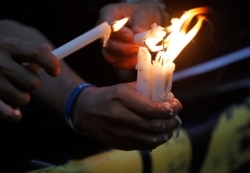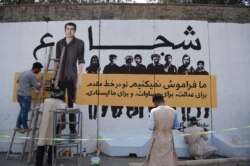A lack of political will or capacity to conduct investigations is hindering progress in obtaining justice when journalists are killed, a report released Wednesday by the Committee to Protect Journalists says.
During the past decade, 230 of the 277 journalist murders worldwide have gone unprosecuted, with a dozen countries accounting for 80% of all unresolved cases, the press freedom organization's 2020 Impunity Index report found.
The index, updated annually, examines countries where journalists are murdered and the killers go free. This year's report was released ahead of the U.N. International Day to End Impunity for Crimes Against Journalists on November 2.
Somalia, Syria, Iraq and South Sudan — all hit by war and political instability — remain at the top of the index. Mexico and the Philippines, which saw some prosecutions but where violence against the media remains a serious issue, also remain on the list.
"It's not surprising to see that impunity rates remain very high because there haven't been any meaningful powerful examples of rapid justice being pursued in the cases of journalists," said Courtney Radsch, CPJ's advocacy director.
In the Philippines
The Philippines, which moved from fifth to seventh place on the index, took a decade to bring convictions in the 2009 Maguindanao massacre of 58 people, including more than 30 media workers.
A regional court last year convicted 28 people for their involvement in the attack. But the country still has 11 unsolved journalist killings in the past decade.
Radsch cited two primary reasons for the impunity. The first is the lack of institutional capacity to conduct investigations or carry out meaningful trials. The second is the lack of political will, which threatens the progress of convictions.
In Mexico
In Mexico, the deadliest country for journalists in the West with 26 unsolved murders in the past decade, authorities secured convictions in two cases, including that of award-winning investigative journalist Javier Valdez Cárdenas. But special units set up to investigate crimes against the media are not doing enough, Radsch said.
Valdez, who was shot 12 times outside his office in Sinaloa state, had received death threats for his reporting on a turf war between criminal groups.
One person was sentenced on February 28 to 14 years in prison, and a second is awaiting trial for the 2017 murder. An arrest warrant also has been issued for a former member of the Sinaloa cartel, who is accused of ordering the murder, according to CPJ.
"There's some level of comfort there, that someone has been held responsible, but there is still more to be done," Radsch said.
Special Rapporteurs on freedom of expression from the United Nations and the Inter-American Commission on Human Rights criticized Mexico in November last year over the slow investigation into Valdez's murder.
The rapporteurs called on Mexico to create a more effective system for investigating such cases and said "the delay in the proceedings directly contributes to the ongoing impunity for crimes against journalists in Mexico. "
Mexico has a special federal prosecutor's office responsible for examining journalist murders. But the CPJ report says it has taken on fewer new cases since President Andrés Manuel López Obrador took office in December 2018.
A major factor that slowed investigations in Mexico, Radsch said, is plans by the federal congress to abolish 54 trust funds, including one used to finance journalist protections. Under the proposals, media safety schemes would be funded through the Interior Secretary. This could make the process more susceptible to political maneuvering.
"This is not a step in the right direction for Mexico, given that it is one of the most dangerous places to be a journalist," Radsch said.
So far in 2020, CPJ has determined at least four journalists were murdered in Mexico because of their reporting.
In Afghanistan
Rights and protections are also at the forefront of Afghan journalists' minds in recent months, as Kabul engages in peace talks with the Taliban in Doha.
In Afghanistan, most murders of journalists go unprosecuted, according to the Afghan media advocacy group Nai. The country moved up one place to fifth place on the CPJ index.
Nai — a nongovernmental organization set up in 2005 to promote independent journalism—has documented 120 media worker and journalist killings in the country since 2001. The group's director, Mujeeb Khlewatgar, told VOA the Taliban was responsible for 55 cases, and that 40 killings remain unsolved.
"No judiciary process for them has been taken," Khlewatgar said, adding that the government doesn't have jurisdiction in areas under Taliban control.
In Afghanistan, 229 districts — or just over half the country — are under the government's control, while 59 districts, roughly 15%, are under the Taliban control, according to a January 2019 report by Special Inspector General for Afghanistan Reconstruction.
The Afghan media scene has experienced tremendous growth in the post-Taliban period, buoyed by international involvement and the passage of a series of laws lending some protection to journalists.
Government officials have said they will prosecute perpetrators in the killings of journalists after the peace talks resolve, but Khlewatgar said he has doubts. Even during the off- and on-again process, journalists were threatened over their coverage of Taliban actions, Khlewatgar said.
"There is no protection system here," he said. "Freedom of expression is not something that we are practicing now."
Radsch said the issue of impunity in attacks on journalists has gained traction on the world stage, but political commitments need to lead to actions and policies. Prosecuting perpetrators, which often is a long and fraught process, can easily be challenged or overturned.
"On the one hand, you have rising international attention and condemnation for such murders, which has helped propel the issue even further on the international agenda," Radsch said. "But translating attention into meaningful prevention remains a challenge."







